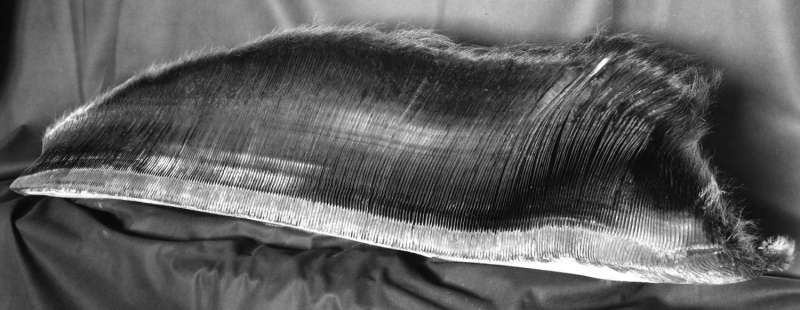Baleen rack of specimen USNM 267999, an 11 m humpback whale (Megaptera novaeangliae) collected in Western Australia, 1938. Credit: Solazzo et al (2017)
Peptide mass fingerprinting accurately identified 10 species of whales from their baleen alone, according to a study published August 30, 2017 in the open-access journal PLOS ONE by Caroline Solazzo from Smithsonian Institution, US, and colleagues.
Baleen whales are found worldwide, and have been traditionally hunted by indigenous people in the Arctic and North Pacific for more than 4,000 years. Prehistorically, baleen was used to make artefacts from clothing to fishing and hunting implements. While DNA analysis of tissues from museum specimens is common, this technique is often difficult or impossible on old baleen.
Solazzo and colleagues assessed whether peptide mass fingerprinting could identify species from baleen, which like hair and fingernails is made mainly from the protein alpha-keratin.
The researchers developed a peptide mass fingerprint for each baleen whale species, using 27 baleen samples from 10 known species of baleen whales to develop the technique. They then tested the technique on 29 archaeological baleen samples of unidentified species from sites in Labrador, Canada, spanning 1,500 years of aboriginal whale use.
The researchers found that they could calibrate the peptide mass fingerprint from known whale species, and use that technique to identify whale species from their baleen. In addition, they found that bowhead whales dominated at the archaeological sites. Identifying whales from the baleen used in ancient artefacts can help archaeologists learn which species prehistoric groups hunted as well as how the resources these marine mammals provided were used. Other applications of peptide mass fingerprinting include wildlife forensics and improving our understanding of how historical populations used baleen and improve present-day conservation efforts.
"Baleen, a material used in a wide range of objects in the past, can now be correctly identified to species," says Solazzo. "This work has again showed the efficiency and importance of peptide mass fingerprinting as an analytical tool for the study of museum artefacts made of proteins."
More information: Caroline Solazzo et al, Molecular markers in keratins from Mysticeti whales for species identification of baleen in museum and archaeological collections, PLOS ONE (2017). DOI: 10.1371/journal.pone.0183053
Journal information: PLoS ONE
Provided by Public Library of Science
























